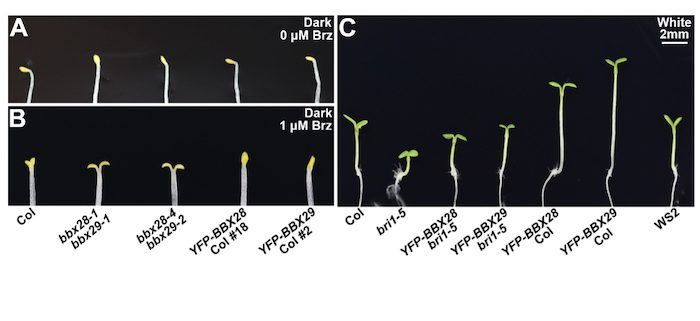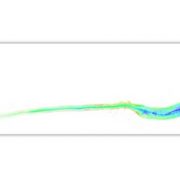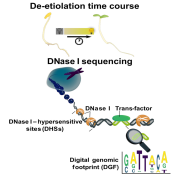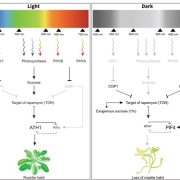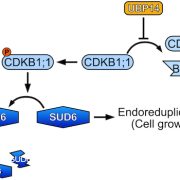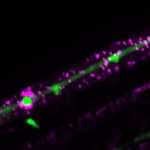A new link between light and brassinosteroid signaling
Cao et al. demonstrate that the photomorphogenic repressors BBX28 and BBX29 enhance brassinosteroid signaling to promote hypocotyl elongation and cotyledon closure.
By Jing Cao and Fang Lin
Background: Light signals and brassinosteroids (BRs) are external stimuli and internal cues, respectively, both of which play critical roles in a multitude of physiological responses throughout the plant lifecycle. Seedlings grown in the light exhibit photomorphogenesis, with short hypocotyls, open and green cotyledons, while BR promotes seedling etiolation, with long hypocotyls and closed cotyledons. Light and BR play opposite roles in controlling the developmental switch from skotomorphogenesis in the dark to photomorphogenesis in the light. Photomorphogenic repressors including COP1, PIFs, BIC1, and AGB1 elevate BR responses, while photomorphogenesis-promoting factors such as HY5, BZS1, and NF-YCs repress BR signaling. BR components also modulate light signaling. Therefore, multiple components of light and BR signaling appear to function coordinately to mediate seedling development.
Question: Are there new integrators of light and BR signaling that regulate plant growth and development?
Findings: Through genetic and biochemical analysis, we found that the photomorphogenic repressors BBX28 and BBX29 positively modulate BR signaling in Arabidopsis seedlings. BR promotes BBX28 and BBX29 protein accumulation in a BR-INSENSITIVE1 (BRI1) and BR-INSENSITIVE2 (BIN2)-dependent manner. BBX28 and BBX29 interact with BR-ENHANCED EXPRESSION1 (BEE1), BEE2, and BEE3 to promote their binding ability, thereby enhancing their transcriptional activity to promote skotomorphogenesis. Moreover, BBX28 and BBX29 as well as BEE1, BEE2, and BEE3 increase BRASSINAZOLE RESISTANT1 accumulation to elevate the BR signaling pathway. Together, these results demonstrate that both BBX28 and BBX29 integrate light and BR signaling by interacting with BEEs to promote their transcriptional activity and precisely regulate seedling development.
Next steps: We are currently examining the roles of BEE proteins in BR signaling to regulate plant growth and development.
Reference:
Jing Cao, Yuxia Liang, Tingting Yan, Xuncheng Wang, Hua Zhou, Chen Chen, Yingli Zhang, Beihong Zhang, Shuhao Zhang, Juncheng Liao, Shujing Cheng, Jinfang Chu, Xi Huang, Dongqing Xu, Jia Li, Xing Wang Deng, Fang Lin (2022). The photomorphogenic repressors BBX28 and BBX29 integrate light and brassinosteroid signaling to inhibit seedling development in Arabidopsis. https://doi.org/10.1093/plcell/koac092


